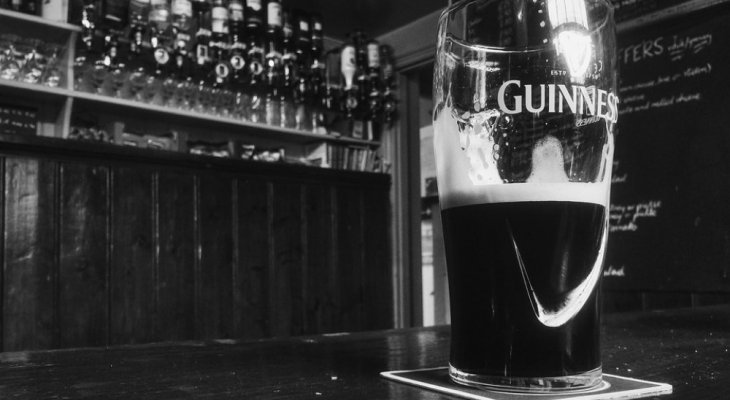How-To: Add Coffee Flavor To Beer! (3 Easy Coffee Beer Recipes)

Lately, I tasted a craft beer that had added coffee flavor and was pleasantly surprised.
In this blog post, I will explain how you can add coffee flavor to your next homebrew, as well as provide some recipes using this method.
How do You Add Coffee Flavor to Beer? There are two ways to add coffee flavor to your beer. The first one is just simply adding crushed coffee beans or powder, usually done in a secondary fermentation but can be done in primary. Another way is deep-roasting grains to give coffee-like flavors but without adding actual coffee.
Read on as I dive into how coffee flavor is added to beer, and other ways to spice up your homebrewed beer.
My Favorite Coffee For Homebrew
- SUPER CREMA: A 2.2 lb whole bean coffee bag ideal for espresso preparation
- INTENSITY AND ROAST: This full-bodied medium roast offers a bold and creamy finish
- BLEND: Made from Arabica and Robusta beans, this naturally caffeinated blend is sourced from 15 coffee-growing countries around the...
Last update on 2025-12-14 / Affiliate links / Images from Amazon Product Advertising API
Now, How do You Add Coffee Flavor to Beer?
If you are bored with your standard brewing routine and want to try something new, you can choose to add extra flavor to your beer. In this blog post, we talk about adding coffee flavor to your beer, which is most common among stouts and porters granted their already dark color and often bitter tastes.
Coffee flavoring in beer is rather rare. The coffee flavor is lacking behind citrus and other fruit flavors in a beer but is still a niche that is explored by more and more beer enthusiasts.
There are two ways brewers add coffee flavor to their beer.
#1 The first one is simply adding coffee, usually done during primary or secondary fermentation, but can also be done in the grain-mashing process.
You have to be careful when adding coffee to your batch. Depending on how strong the coffee is you may have to add more or less to create a well-balanced taste that isn’t too powerful or too weak.
Find out what type of coffee beer you want to brew, and add coffee accordingly.
Some use coffee flavoring in beer just to give a little hint of coffee, while others want coffee to be the dominant taste in the beer.
Whatever you desire, experiment with the values you add to your batch to find the perfect balanced taste for you. #2 The second way actually doesn’t involve real coffee, but rather a coffee-like flavor using roasted grains.
This method is also done when adding chocolate flavor to beer. When you deep-roast barley malts they can give off different scents and tastes ranging from chocolate-like flavors to very bitter coffee-like flavors.
Using these malts is done usually in the mashing of grains, where you just substitute some of your usual grains for some highly-toasted barley malts to give off a coffee-like flavor in the end product.
Whatever type of method you choose to add coffee flavor to your beer, you can get very satisfying results messing around with these things in your brewing process.
When Do You Add Coffee to Beer?
Looking at multiple recipes, there doesn’t seem to be a right or wrong answer as to how much coffee to add, and when.
Coffee can technically be added in all stages of the brewing process, in various ways.
Every beer recipe involving coffee can be different, there is no set-in-stone way to add coffee flavor to your beer, so don’t get too hung up on finding the “right” way to do it, since each method can give nice results.
Some methods add the coffee during mashing, some during primary fermentation and some secondary fermentation, there really is no right way to do it, but the results may vary depending on which method you choose.
If you are using coffee beans, whole or crushed, placing them in a grain bag is probably wise. This makes racking and/or siphoning a lot easier since if you add whole beans they might cause quite a mess and potentially clog your tubes.
TIP: use split or crushed coffee beans as they usually give off more taste and aroma than using whole beans.
The most popular method overall is adding the coffee flavor during primary and secondary fermentation.
The reason for this is that the flavor of a beer is largely decided in the fermentation process, so adding coffee flavor during this will usually give more powerful and robust coffee flavors compared to adding it during mashing/boiling or carbonating.
Some brewers/breweries do add coffee during bottling or kegging with good results as well. The carbonation process also increases the flavor and general feel of a beer, so adding coffee during this stage is also a popular and easy way to spice up beer brewing.
How Many Beans do You Add to Your Homebrew?
The tricky part about adding any flavor to your beer, is finding the right dimensions to add. It all depends on how powerful of a flavor you want.
There is a line where you go from having a good flavor to ruining your beer. If you add too much coffee you might overpower your beer and essentially just end up with a bad tasting coffee with bubbles.
Using too little may result in most of the coffee flavor being boiled out and not actually doing anything positive for your beer.
To be safe, the use of already made recipes is a safe way to add the correct amount of coffee.
If you aren’t ready to experiment yourself, you can simply find a recipe that tells you how much to add and when. You can find some nice recipes further down in this post that might suit you.
You can also try your luck and contact a local brewery and ask them if they know anything about adding coffee to beer, and if so, ask them how much they normally add.
What Kind of Coffee is Best for Homebrewing?
A commercial brewery might be forced to buying beans they know are in high stock, to make sure the supply doesn’t run out unexpectedly.
However, as a homebrewer, you can virtually use any coffee you desire. The market for small niche-type coffees is vast, so making a choice might be hard, but there is definitely a coffee out there that suits your homebrewing needs.
Experimenting is the way of homebrewing, try out some fun methods and different coffees to find your own unique flavor.
You can try roasting or grinding your own beans to a level that you feel is different and fits your beer.
In terms of what type of bean to actually use, most homebrewers, as well as many breweries, agree that the use of Arabic type beans is the best.
The world of coffee beans is vast, and they all have various properties depending on the type.
Using some stronger types of coffee such as French roast or espresso type coffee can give your beer a very robust and powerful presence.
If you use some lighter type roasts like Guatemala Antigua or Sumatra you will get a bit more of a subtle hint of coffee where the taste isn’t as dominated by coffee as with darker roasts.
Some darker roasts like the French roast can also add some nice mouthfeel to your beer since they can contain oils that change up the general consistency of your beer.
So there really is no number #1 best coffee for homebrewing, do a quick search on various forums, see what works for others, or simply try experimenting yourself to find your own recipe.
Nowadays, there are plenty of coffee manufacturers to choose from. Get some inspiration by clicking here (Amazon link) and find the best coffee beans for you.
Conclusion
In conclusion, you can generally add coffee to beer in 2 main ways, either by adding actual coffee in form of beans of powder or adding grains that have been roasted deeply, giving off a taste similar to coffee.
There are many different ways to use coffee in terms of how much to add, which type to add and when in the process to add it.
You can experiment yourself or simply follow existing recipes if you want to craft some of your own delicious coffee-flavored beer.
If you want to make your own coffee stout you can check out some delicious coffee stout recipes below!
Coffee Stout Recipes
If you are interested in coffee beer brewing, here are some recipes for you!
They are all stouts, since stouts are the most popular beer that contains coffee.
Other beer types are starting to enter the picture, but generally, stouts are the most popular because coffee seems to work best in combination with the dark, strong type beer that a stout is.
Mudhouse Stout
Ingredients:
- 8 lbs. 2-row pale malt
- 0.50 lbs. Roasted barley
- 0.25 lbs. Chocolate malt
- 0.25 lbs. Crystal malt
- 0.50 lbs. Weyermann Carafa III
- 21 oz. fresh-brewed coffee
- 0.50 oz. Cascade hops(flavor)
- 1.0 oz. Cascade hops(aroma)
- White Labs WLP001 (California Ale)
- 0.33 oz. Nugget hops
Step by Step:
- Mash grains at 155-158F for about an hour
- Sparge at 168F and aim for 5 gallons of wort after boiling
- Bring to a boil and add nugget hops, boil for 70 minutes and remove them
- At 60 minutes add first cascade hops then turn off the heat
- Add second hops
- Add yeast and ferment at 64F
- Primary is 3 days, afterward, let it rest for another 2 days at 64F
- After primary is done, cool to 52F and let it sit for 4 days
- Chill all the way to 32F and let it sit for a week
- Add coffee once the beer is at 32F
- Add 21 oz. fresh hot coffee
- Let it sit for a week
- Bottle and let it carbonate
- Enjoy!
Coffee Imperial Stout
Ingredients:
- 2.25 lbs. Crystal Malt
- 1.25 lbs. Chocolate Malt
- 0.5 lb. Black Patent Malt
- 8.0 lbs 2-row Pale Malt
- 0.5 lb. Roasted Barley
- 1.5 lbs. Wheat Malt
- 2.5 oz. Northern Brewer Hops
- 1.5 oz. Finishing hops – Northern Brewer or Cascade
- 15 oz. Espresso
- Ale Yeast
Step by Step:
- Mash all grains at 150F. For about an hour
- Mash out at 170F and begin sparging
- Sparge to about eight gallons worth of wort
- Bring wort to a boil and add your 2.5 oz. of hops. Boil for about 60-70 minutes
- Turn off the heat and add your finishing 1.5 oz. hops. Let it sit for 5 minutes
- Cooldown to 70F
- Add your ale yeast to start fermentation
- At the end of fermentation add your espresso
- Bottle and carbonate
- Enjoy!
Buzz’ard Double Chocolate Espresso Stout
Ingredients:
- 0.5 lb. Roasted Barley
- 0.5. Lb. Crystal Malt
- 0.5 lb. Chocolate Malt
- 8 lbs. dark malt extract syrup
- 1 lb. Ghirardelli Select Brown Chocolate Powder
- 0.5 lb. espresso beans, fine ground, brewed to 1 gallon
- American ale yeast(Wyeast 1056 preferably)
- 1 gallon of coffee
- 2 oz. Northern Brewer Hops
Step by Step:
- Put your grains in 2.5 gallons water, heat to 170F.
- Let it sit for 25 minutes.
- Dissolve extract
- Once dissolved, add 1-½ oz. of hops and chocolate (stir to make sure it doesn’t stick to bottom or sides)
- 45 minutes later add the remaining hops and let it boil for 60 minutes.
- Turn off the heat, chill to 88F and transfer to carboy with 1-½ gallons of water.
- Pitch your yeast at 78F.
- After primary fermentation is complete, rack to your secondary.
- Store it in a cold place at 60F for 45 days.
- Rack to a bottling bucket and add one gallon of room temperature coffee and ¾ cup bottling sugar. Stir it and then bottle.
- Let it carbonate
- Enjoy!
Read Also: Best Beer Recipe Kits




